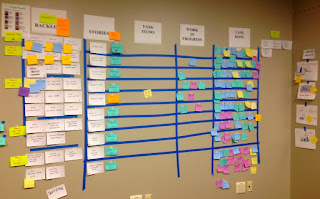Every time I join a team that is physically co-located I propose to use a big-ass-board to track work and visualizes stuff. Usually, there are a couple of questions around these boards and I point people to different blog posts which I collected on my Brain Noise Blog http://gfader.tumblr.com/tagged/taskBoard.
Cage fight!!!
Before we dig into these great points, let me clarify 6 observations I made in the past.
#1
Software development work is not visible. That’s the reason I prefer “Information Radiators” instead of electronic boards that act like “Information Fridges”.
Information Radiators (Visual Management) allow everyone to quickly see what’s going on:
 Figure: Jira is an Information Fridge (Tip from the Kanban in Action book)
Figure: Jira is an Information Fridge (Tip from the Kanban in Action book)
Information fridges hide work. You need to open the fridge, in order to see inside it, dig around it and hopefully find what you were looking for.
Information Radiators are a public display of information in a highly-visible location so that anyone can see and comment on it. This can be hand-written, printed or electronic and could be dashboards, charts, metrics or task boards. Also called Big Visible Charts and used within Informative Workspaces. This is opposite to Information Fridges where information is hidden and cannot be seen within specific access.
From http://pragmaticscrum.info/agile-glossary/
#2
In my experience, physical boards involve more senses and make the people working with the tool more committed and engaged in their work.
#3
A physical board invites other people (non-Jira or TFS users) to join the conversation. They might ask questions and you can collaborate on work items on the board immediately.
This is a great opportunity to work together with the end-user or management people. These people feel usually detached. Get them on board!
#4
Last but not least a physical board is easy to manipulate. Everyone can use am Index card, Post-It, and a pen and collaborate on that board. With electronic tools, there are hundreds of issues like keyboard layouts (German vs English), shortcuts, URLs for Boards, Drag and Drop, Mouse Speed, Screen size and a lot more that hinder you from working together.
#5
Your workflow changes over time because you adapt your practices and your way of working together. As your workflow changes, you need to adapt your board that reflects this.
Electronic tools and boards are harder to change and usually you need a TFS or Jira Master to do so.
Physical Boards are easy to change and the whole team is involved in it.
 Figure: Are you still visualizing "Todo, InProgress, Done"?
Figure: Are you still visualizing "Todo, InProgress, Done"?
Board example from https://mysoftwarequality.wordpress.com/2013/09/10/how-i-stopped-logging-bugs-and-started-living-happy/
#6
The Physical Board is for the team, and the team should set it up, work on and change it. By letting the team set it up they make it theirs. They are more committed because it's theirs and more proud of it.
Thanks for reading this far...
Now back to the 5 valid reasons for an electronic tool and some input to stretch your mind.
1. Single Source of Truth
What if the single source of truth is your codebase?
What if you document your production code with executable specifications?
What if you deliver working software so quickly that there is no need to write every bits and piece down? Instead, you collaborate over prototypes, mockups, working software...
4. Change and History Feature
I think it all comes down to:
What do you do to increase collaboration with the end user?
References for further reading:
This time I got 5 great reasons for using an electronic task board, that I want to answer here.
Cage fight!!!
Physical Boards VS Electronic Boards
Figure: Physical VS Electronic Boards - Thanks, Google Image Search
Peter, I think these are 5 advantages of an electronic task board. What do you think?
- Single Source of Truth
- No media disruption between code and board.
Some people like to relate tests or code pieces to ticket numbers - The electronic board is always available.
At home office or in another meeting room - Change and History Feature
- Lots of space to describe a story or bug in all details
Before we dig into these great points, let me clarify 6 observations I made in the past.
#1
Software development work is not visible. That’s the reason I prefer “Information Radiators” instead of electronic boards that act like “Information Fridges”.
Information Radiators (Visual Management) allow everyone to quickly see what’s going on:
- What’s blocking?
- Is everything healthy?
Use a Build Monitor and a System Monitor - Are we on track?
Show Scope and updated Budget from our accounting system on a 3rd monitor

Information fridges hide work. You need to open the fridge, in order to see inside it, dig around it and hopefully find what you were looking for.
Information Radiators are a public display of information in a highly-visible location so that anyone can see and comment on it. This can be hand-written, printed or electronic and could be dashboards, charts, metrics or task boards. Also called Big Visible Charts and used within Informative Workspaces. This is opposite to Information Fridges where information is hidden and cannot be seen within specific access.
From http://pragmaticscrum.info/agile-glossary/
#2
In my experience, physical boards involve more senses and make the people working with the tool more committed and engaged in their work.
#3
A physical board invites other people (non-Jira or TFS users) to join the conversation. They might ask questions and you can collaborate on work items on the board immediately.
This is a great opportunity to work together with the end-user or management people. These people feel usually detached. Get them on board!
#4
Last but not least a physical board is easy to manipulate. Everyone can use am Index card, Post-It, and a pen and collaborate on that board. With electronic tools, there are hundreds of issues like keyboard layouts (German vs English), shortcuts, URLs for Boards, Drag and Drop, Mouse Speed, Screen size and a lot more that hinder you from working together.
#5
Your workflow changes over time because you adapt your practices and your way of working together. As your workflow changes, you need to adapt your board that reflects this.
Electronic tools and boards are harder to change and usually you need a TFS or Jira Master to do so.
Physical Boards are easy to change and the whole team is involved in it.

Board example from https://mysoftwarequality.wordpress.com/2013/09/10/how-i-stopped-logging-bugs-and-started-living-happy/
#6
The Physical Board is for the team, and the team should set it up, work on and change it. By letting the team set it up they make it theirs. They are more committed because it's theirs and more proud of it.
Thanks for reading this far...
Now back to the 5 valid reasons for an electronic tool and some input to stretch your mind.
1. Single Source of Truth
What if the single source of truth is your codebase?
What if you document your production code with executable specifications?
What if you deliver working software so quickly that there is no need to write every bits and piece down? Instead, you collaborate over prototypes, mockups, working software...
2. No media disruption between code and board.
Some people like to relate tests or code pieces to ticket numbers
What if your codebase lives for 10 years, but your TFS Installation or Jira gets replaced with a better tool just around the corner?
How could you document the ticket details in your codebase?
How could you document the ticket details in your codebase?
3.The electronic board is always available, at home office or in another meeting room
What if the board location is your meeting room?
What if you take IndexCards or PostIts home? Remember to get them done and bring them back ;-)
What if you take IndexCards or PostIts home? Remember to get them done and bring them back ;-)
4. Change and History Feature
5. Lots of space to describe a story or bug in all details
What if instead of managing work your get more work done, so you don't need the change and history feature? What if you increase your delivery speed?
How can you increase your delivery speed?
How could you decrease the feedback loop to the end users?
How can you measure faster the impact on your business?
How can you try ideas as you think of them?
What if instead of managing work your get more work done, so you don't need the change and history feature? What if you increase your delivery speed?
How can you increase your delivery speed?
How could you decrease the feedback loop to the end users?
How can you measure faster the impact on your business?
How can you try ideas as you think of them?
I think it all comes down to:
Shorten the feedback loops to the end user
&
Break down the silos between the development team and end user
What do you do to increase collaboration with the end user?
References for further reading:
- Kanban in Action book
https://www.manning.com/books/kanban-in-action - Kanban boards step by step
https://www.slideshare.net/GiulioRoggero/how-a-kanban-board-works




8 comments:
What if the “electronic” board was displayed on a huge always-on digital whiteboard so you can have the best of both worlds?
@James: Still when observing a daily in front of a tangible board - how quickly some magnets are moved simultanously by team members and how easily a new area is introduced (or removed) or new tasks are written - you still don't have the best of the physical board world.
@James and Unknown:
I agree. With a physical world you have people jumping in and everyone can collaborate and contribute easily.
Software Development is very abstract and a physcial board makes it visible.
Visualising is just the 1st step. Reading the board and acting on the things it tells you is POWERFUL.
PS: As an author I am sad that all my old comments here are lost... Well Thanks Google+ and Blogger Platform.
I am a big fan of having a physical board to visualize the sprint tasks. Alas, my team is not co-located. Only 2 people on the 8 person team are co-located, and the other 6 people are each in a different state. The second biggest advantage of having a physical board for the sprint tasks over an electronic tool such as Atlassian Jira is the clean segregation between Product Backlog and Sprint Backlog.
The biggest advantage is as per Kelly Waters in his "How to Implement Scrum in 10 Easy Steps" series:
"Like email compared with face-to-face communication, no tool will replace the sense of collaboration and teamwork this focal point provides. Yes, it might be more efficient to use a software tool. But efficiency isn’t everything. Effectiveness is more important than efficiency."
Another important point I learned:
Boards do not force us to commit ourselves, but encourage the spitting out of thoughts for further discussion.
--> Which is what we want in a team.
Another one:
+1 on physcial boards:
-> It is much easier to ignore a board in a software far away...
This actually works quite well with the ticket tool already in use ;)
Post a Comment